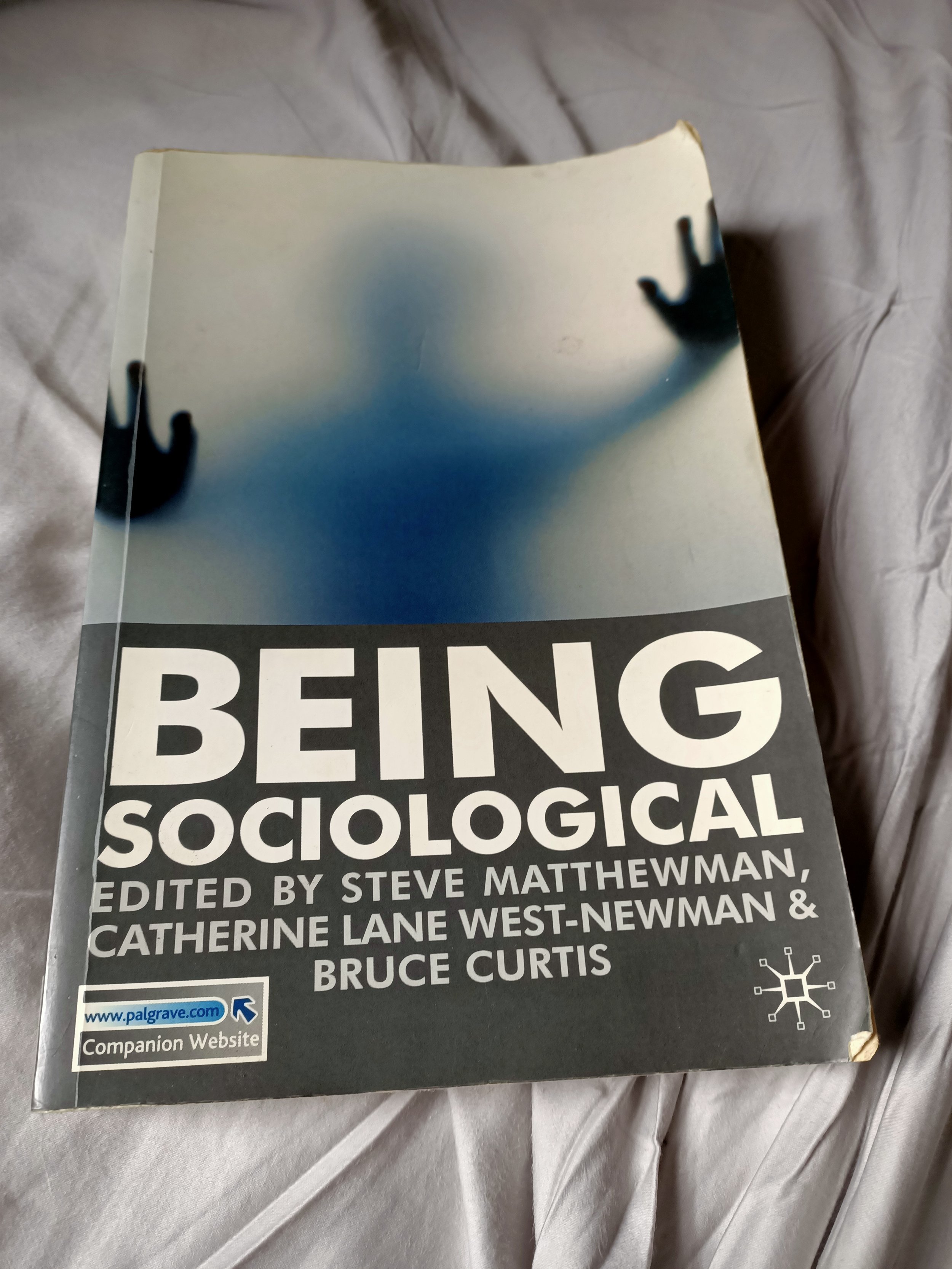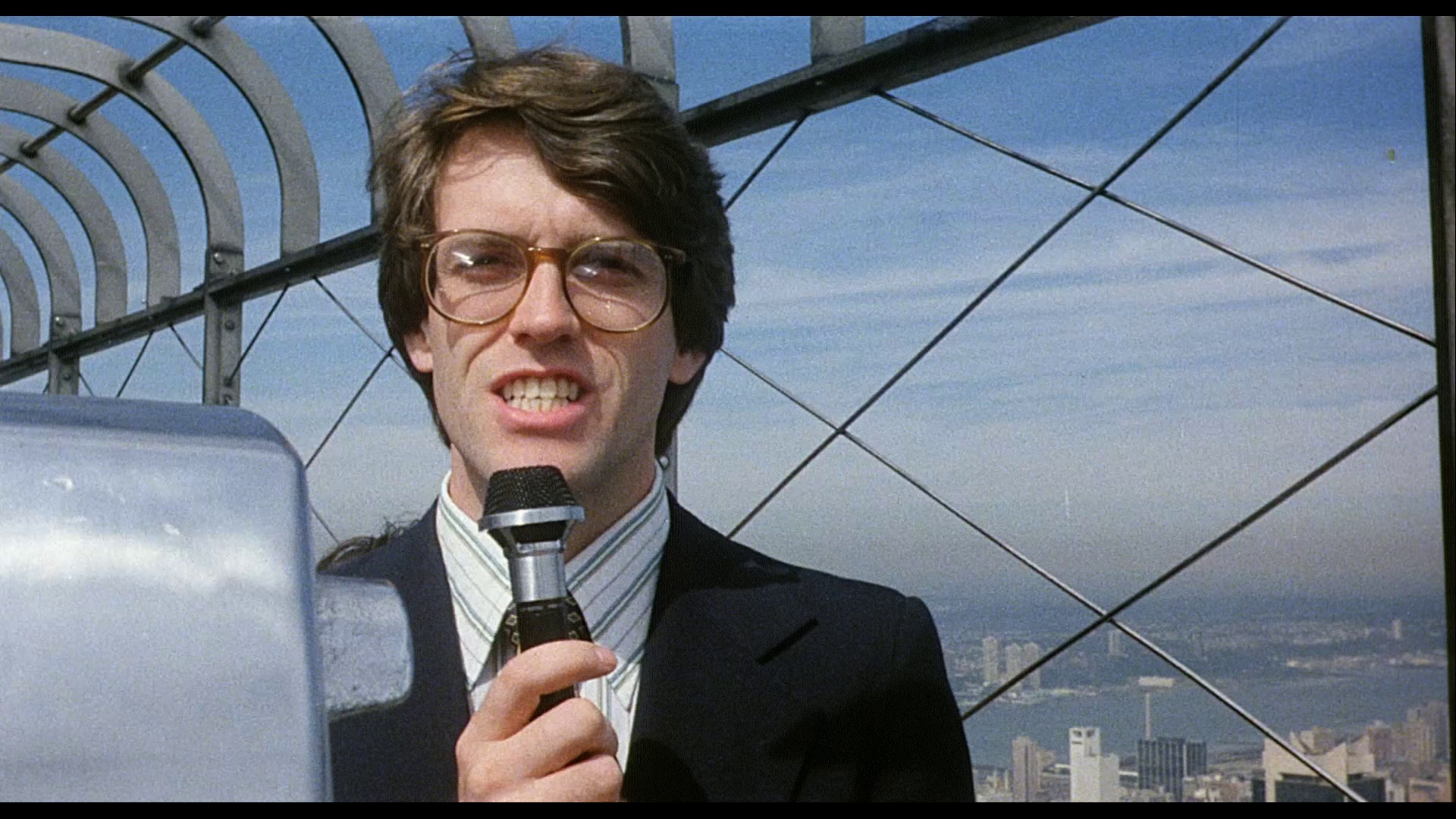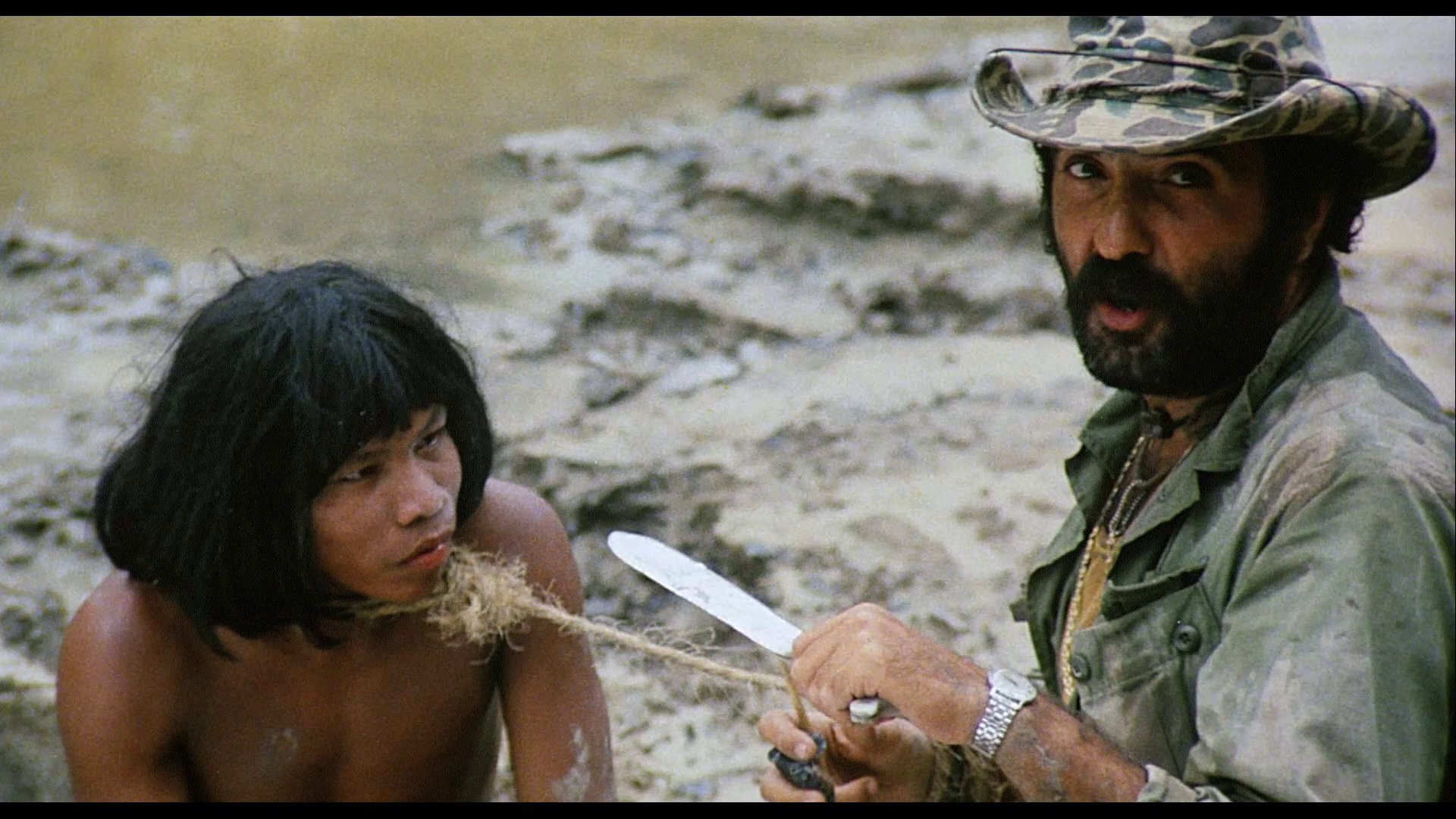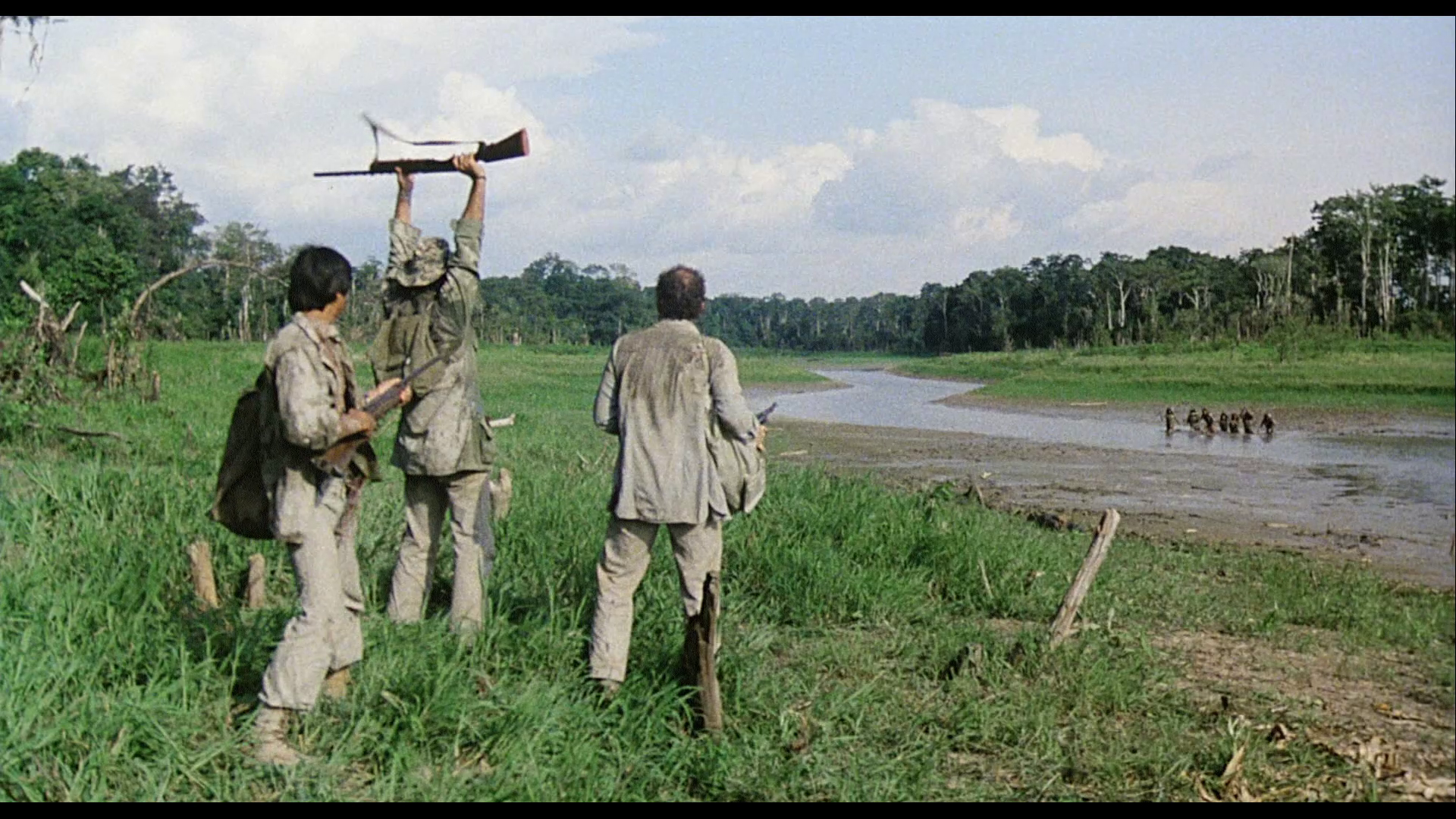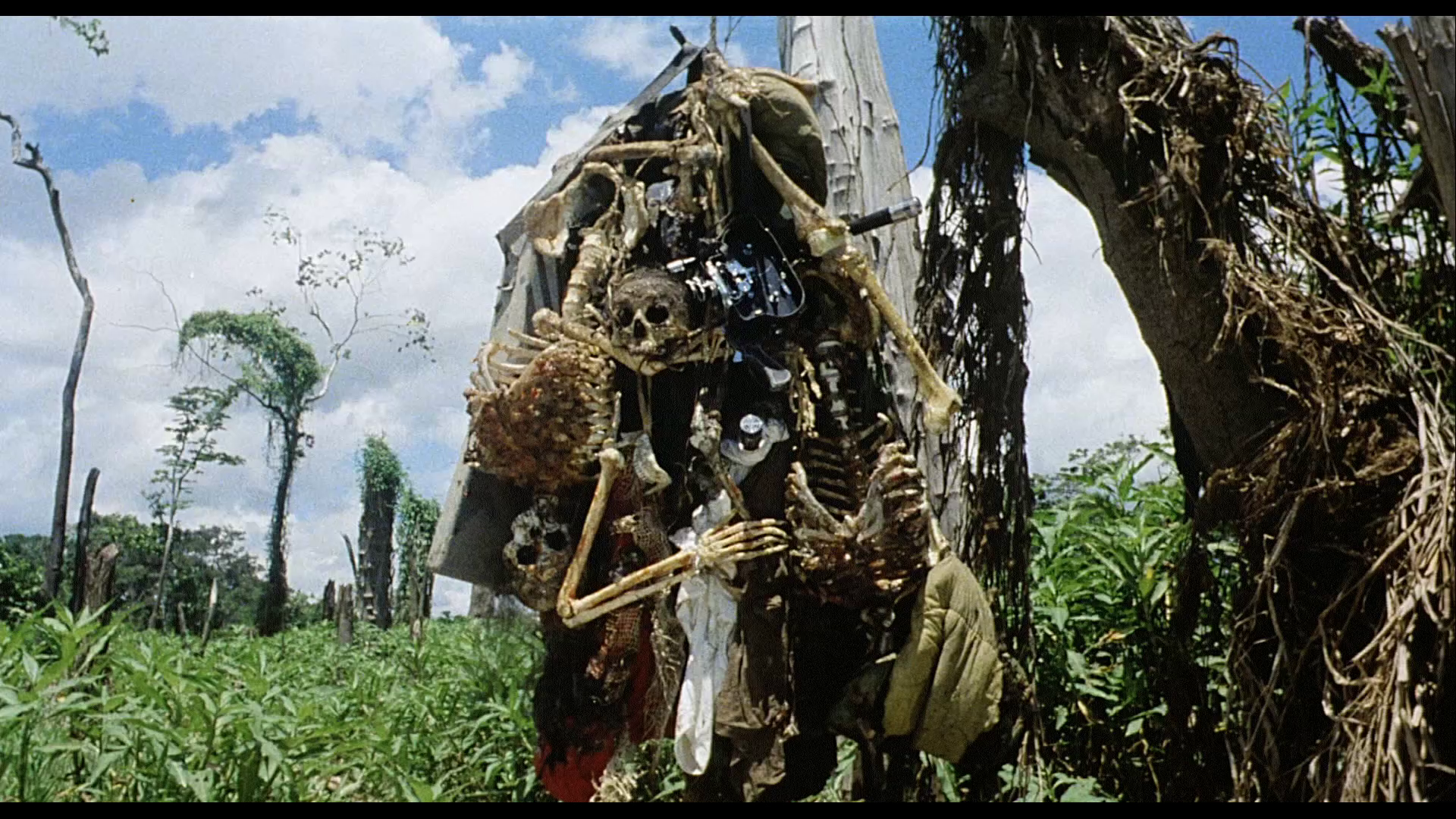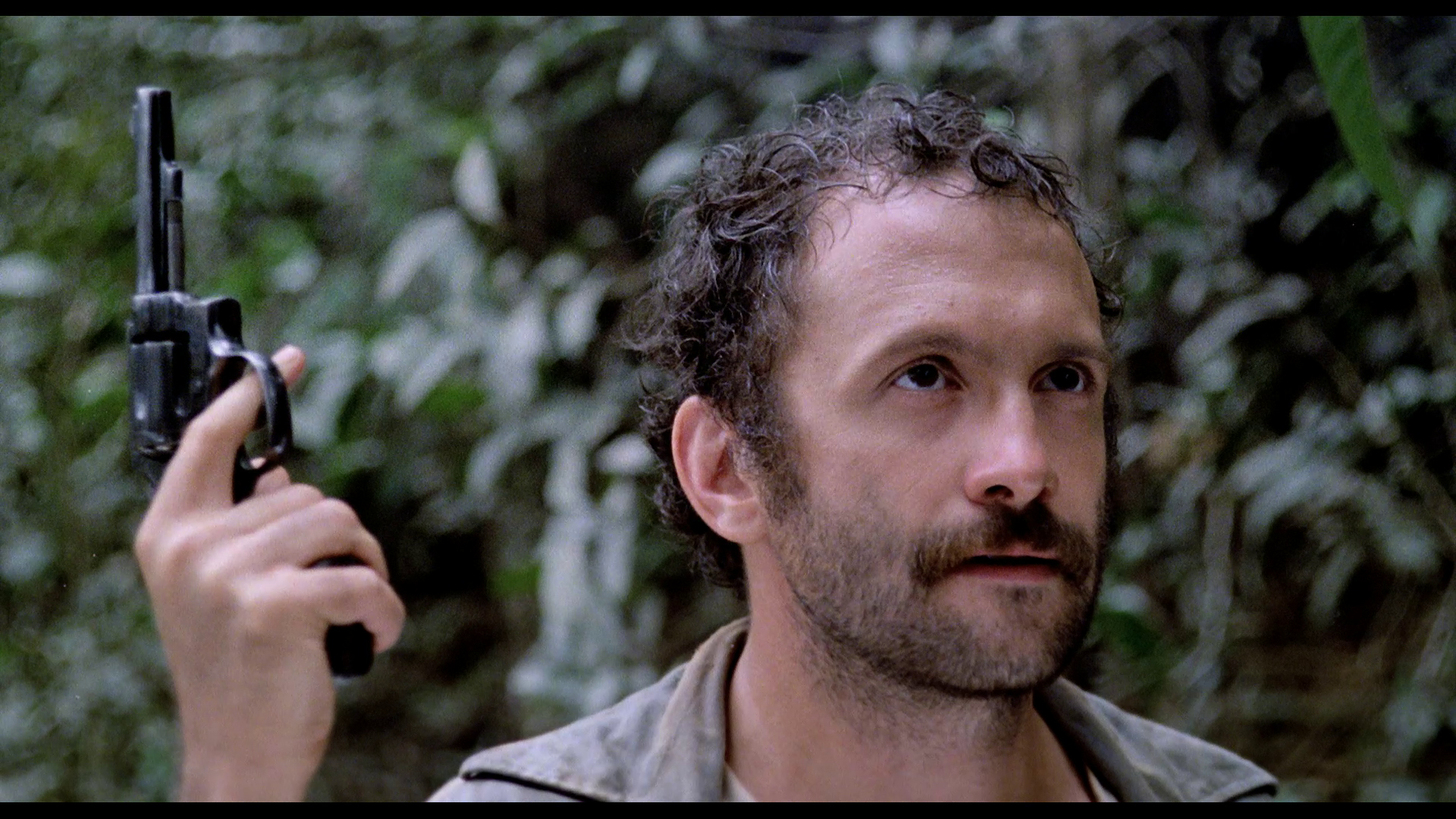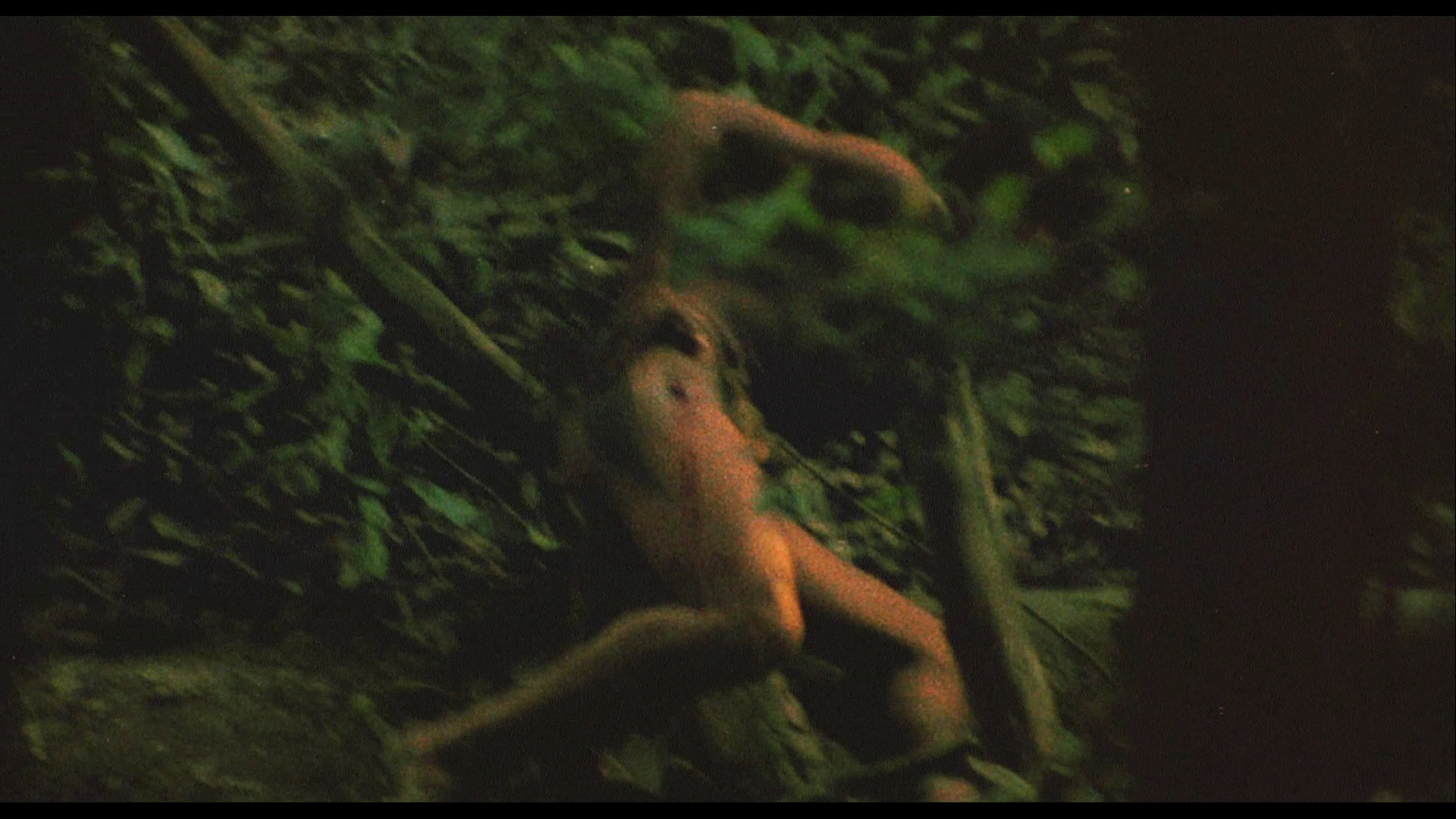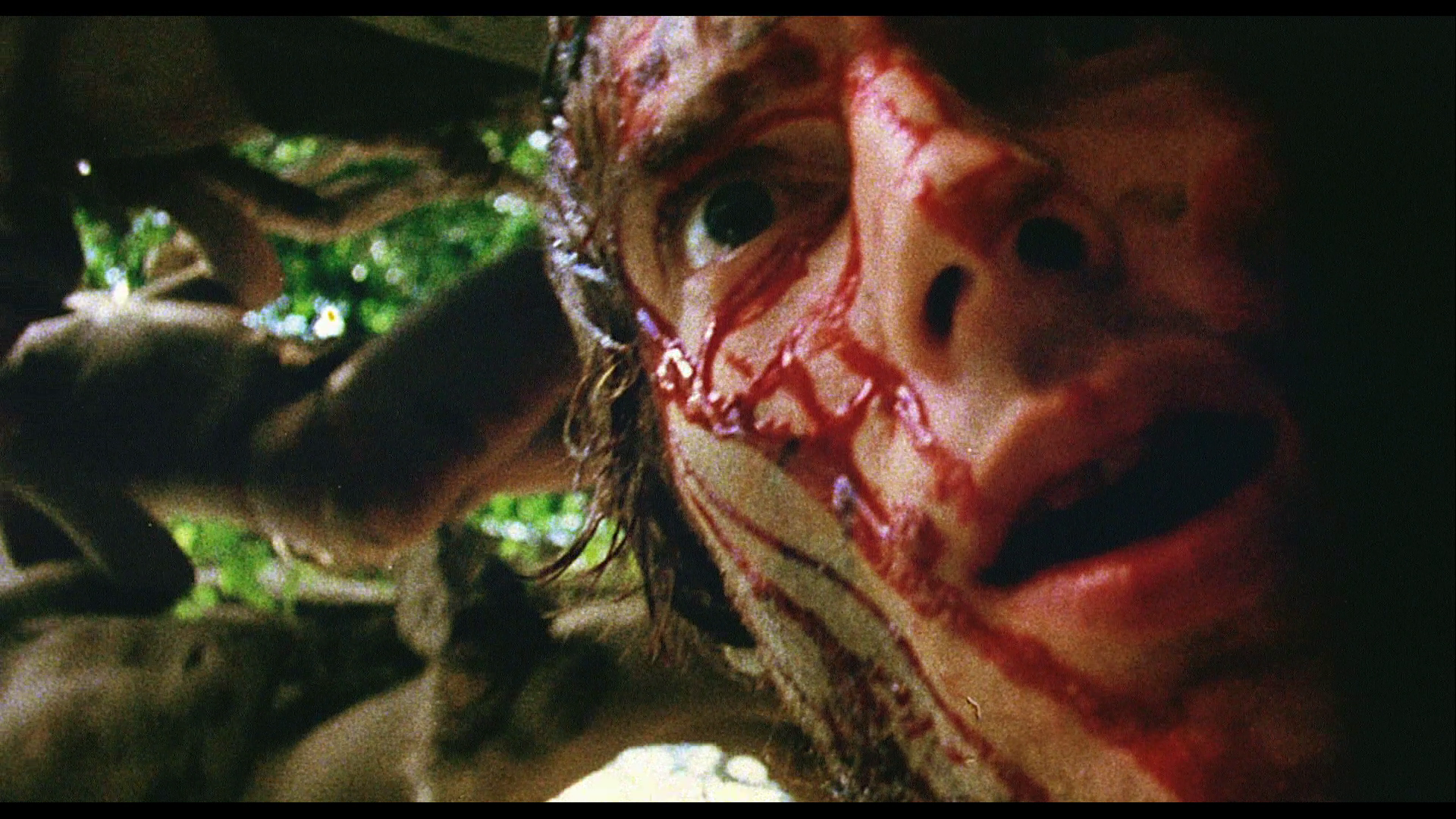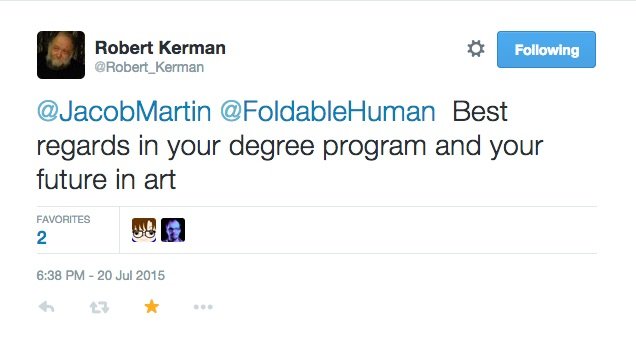Graduating from the Class of Professor Monroe
TRIGGER WARNING: This essay discusses Cannibal Holocaust and something worse.
My journey into appreciating horror has had its ups and downs, from my first brush with the Friday the 13th franchise startled by Jason jumping out of the water, to watching the exhilarating chainsaw duel in Panos Cosmatos’ Mandy at the Hayden Orpheum, to being there when the 2018 Halloween direct sequel was in theatres - I haven’t seen everything the genre has to offer, I didn’t start out as a badass who’d buy a Blu-Ray of Martyrs and general admission Slayer tickets. I was a former wuss who avoided horror instead of becoming a friend of it, freaked out by Rail Chase at Sega World Sydney and hesitant to try anything too spooky. That changed of course, by the time I was in college I was seeking out banned exploitation movies like Caligula which I got an uncut copy of from EzyDVD Burwood when they still had a brick and mortar shop. I acquired Salo when it had been given an R-18+ certificate by the OFLC I despised, because they did not protect me well enough with their ratings advice when I needed them the most. More on that later. Then a little film called Cannibal Holocaust came to my attention, I’d seen the DVD stocked amongst the shelves at JB Hi-Fi where I bought most of my physical media, but until a now-cancelled filth elder I respected did a comedic review of the film I wasn’t game enough to touch it, let alone buy it for my personal collection of home video. The first time you watch a horror movie which is truly scary, there’s always the sense of dread of what could await you in the sections which film critics only hint at in their reviews for the sake of reducing risk of spoilers. Cannibal Holocaust shocks from the very title alone, it’s a film hard to defend due to its copious amounts of animal cruelty, because some absolute madman named Ruggero Deodato decided it was worth the risk of being pilloried for having made an alleged snuff film by blurring the lines of hyper-reality with graphic special effects and actual scenes of butchering a turtle to convince you that the rest of the violence is more than an “impaled” woman sitting on a bicycle seat with a piece of balsa wood in her mouth. I have at times gotten defensive when Cannibal Holocaust receives criticism for this unpleasant aspect baked into the celluloid of its being, and it’s hard for me to recommend Cannibal Holocaust as a work of cinematic genius when the process of its creation mutilated animals for entertainment. It’s also not the worst movie I’ve ever seen by a long-shot, but I’ll get to that.
I love how Riz Ortolani continues to inspire artists to reinterpret his beautiful music for video nasties, like this absolute chad H.M. Hammarin making Cannibal Holocaust sound romantic.
The reasons why I continue to defend Cannibal Holocaust transcend simple edge-lord shock-jockery, but to really delve into why Cannibal Holocaust changed my life we have to get a bit autobiographical. See, back when I was stuck in the trenches of my Pathways Program where I did my HSC over a number of years instead of all at once, I had an elective called Society and Culture which kept me sane. It was not available to previous students who abandoned me to graduate up to college, and this class was one of the few respites from clinical depression I had during this dismal period in my life. It was my first taste of anthropology proper, and with the help of my aptly named teacher Mr. Champion I fell in love with the social sciences. I did my Personal Interest Project comparing “masculinity in the movies”, contrasting Hollywood in Fight Club to Bollywood in Shah Rukh Khan’s classic Devdas. Unsurprising results ensued, teenagers from Queensland who shall remain anonymous thought the more openly emotional Shah Rukh Khan was a bit “gay” compared to Brad Pitt when I did a focus group with them.. These kids disrespected Shah Rukh Khan, icon and sex symbol in Bollywood, because they didn’t know any better and I wasn’t allowed to judge their ignorance of Indian cinema’s premium grade hunks, and if I reminded them of this hotness I would have been accused by them of being homosexual myself. I was very young then and didn’t know what to do about Brad Pitt’s Tyler Durden being seen as a better role model than Shah Rukh Khan as a lower class Indian in love with a woman so much that he’s weeping over her. This focus group taught me a depressing lesson in Australian masculine ideals, and I suppose I should be grateful they provided their unfiltered opinions for the accuracy of my research.
I couldn’t find my Personal Interest Project (PIP) in the garage, but I found this old textbook as evidence of my academic curiosity instead. I didn’t even get this tome from high school, I was so hungry for knowledge about sociology, that I took it from a university clearance giveaway.
Mr. Champion gave me good marks for my Personal Interest Project, and he was a companion when I had few of those to go around. I appreciated this education in concepts like globalisation and cultural relativism, one of my assignments was covering the otaku subculture when I was obsessed with anime and still blogged about it often. My homework on Speed Racer kept me occupied and gave me something to talk about with the other students, I recall doing an assignment on the Amish with Harrison Ford starring in Witness as a featured text of study. I still have the mini-DVD discs in my storage boxes which I can never reveal to anyone because of the terms and conditions of my focus group study and the ethics involved. Society and Culture was a winner in my books, and at the tail end of my high school career I couldn’t have asked for a better source of academic comfort food. As an autistic adult I was now learning about how men talk to other men about stuff, and how masculinity functioned, long before the toxic prefix complicated everything in my mind about who I was and what I could be. I still owned a fedora (which I later donated to Vinnie’s to get that relic of my Sensitive New Age Guy phase out of my house), and I grew past adolescence prior to Jordan Peterson ruining the discourse of manhood by attacking Marxist thought and belly-aching about BIPOC feminists having problems with white straight men.
Society and Culture remains a hazy melange of pleasant memories from my secret past as someone that could’ve majored in anthropology, but I majored in Photomedia (now Media Arts on my Sydney College of the Arts diploma) instead, because I wanted to be around creative people and artistic ideas. Mr. Champion moulded me into a student who was eager to learn about the world around me, and I miss him a lot, but one day I would find his cinematic equivalent in the performance of Debbie Does Dallas porn star Robert Kerman. The Kerminator, who appeared in Cannibal Holocaust, Cannibal Ferox and Eaten Alive (as well as a brief appearance in the first Sam Raimi Spider-Man film) exemplified all I had learned from Mr. Champion in my classes, a refusal to kowtow to racist imperialist thought, even if Mr. Champion didn’t have the porn-stache or a pipe like Professor Monroe did in Cannibal Holocaust the anti-imperialist ethos towards what we called “developing nations” instead of primitive was there. My autistic obsession with Robert Kerman’s Professor Monroe character wasn’t sexual in nature, I just saw a handsome guy who was wiser than the average American about places in the world that weren’t the United States. There was no fear that he was going to invade your country for oil in the name of freedom and liberty, he was just going to spill the straight facts about the situation. Every time I watch Cannibal Holocaust, he is the guiding light that leads me out of the darkness, and each viewing I can trust that Professor Monroe isn’t going to leave me behind.
Before we get to the Kerminator, we’re introduced to the exposition by this news reporter who calls the missing camera crew “children of the space age”, whatever the hell that means.
The actors in Cannibal Holocaust are all smiles now, but they won’t be grinning when an Italian tyrant with a camera holds them hostage deep in the rainforest working for mere pesos a day.
Cannibals munching on a human arm deep in the jungle, finger licking good!
Professor Monroe arrives by plane, landing on water and giving his greeting party a wave.
Professor Monroe gets a briefing for his expedition into the jungle from paramilitary dudes.
Professor Monroe is a rare breed in Western media, he is neither Willard from Apocalypse Now who carries the “savagery” of the jungle with him after killing Col. Kurtz, nor is he the stereotyped grave robber that Indiana Jones is as the poster child for archaeology and the imperialist theft that comes with that brand of pulp adventurer’s profession. I love Indiana Jones, but he’s concerned with the stuff created by world cultures rather than the people affected by the actions of imperial powers plundering from developing nations who have no say in where these priceless treasures end up. In an era where we’re decolonising our approach to stolen artefacts with The Unfiltered History Tour and initiatives like it, Indy is the hero who feels like the old relic who should be in a museum whilst Professor Monroe has yet to reveal his message to a mainstream audience. The unfortunate animal cruelty contributes to Cannibal Holocaust being overlooked, and Robert Kerman disowned the film over these sequences. Most people will avoid or seek out the animal cruelty-free cut of Cannibal Holocaust, and it’s sad that Robert Kerman’s excellent performance as one of the film’s few likeable characters gets saddled with the baggage of this explicit content. Cannibal Holocaust is disturbing to sit through for a lot of reasons, such as the dissonant soundtrack by Riz Ortolani whose opening theme sounds like a dying dream almost, but Kerman isn’t one of them. He lends this movie a gentle, poignant soul it wouldn’t otherwise have, and for evidence of that see other cannibal cycle movies from the time like Cannibal Ferox where subtlety is thrown out the window like so many dismembered genitals. I was bummed out when Umberto Lenzi died, I liked his The Man From Deep River a lot, but for my money Cannibal Holocaust aims to a higher purpose and Lenzi’s Ferox revels in the mutilation of both animals and human characters for a rather hollow moral about violence breeding more violence tacked on at the end. Cannibal Holocaust bothers to follow through with its satirical point, Professor Monroe is distinct from his other appearances in Eaten Alive as a somewhat cranky jungle explorer for hire, and Cannibal Ferox as Lt. Rizzo. He’s more of an academic thrust into the bush by what we find out to be tragic circumstances. He’s likeable, even though he sometimes vomits at what he sees, and condemns the drug use of his tracker guide Chaco and a captured villager doing cocaine. This scene progresses to the on-screen killing of a coatimundi by one of the tracking party members using a switchblade, mutilated by the actor who murders it in a less than humane fashion. I’ve never seen the animal cruelty free version for myself, subjecting myself to the full strength experience has always been my preferred viewing because that’s how I first saw it and not having those scenes there feels weird to me. It’s upsetting, and it should be, however I once showed this movie to a female Fijian-Indian friend and she was more disturbed by the fake rape scenes than the genuine animal cruelty. I’m non-binary, a he/they and I’m still learning about the parts of me that are woman, and I’ve figured out most women are afraid of being raped more than they are of anything else in horror movies. It’s a legit concern, on a primal level I don’t yet understand, and when I get asked to accompany female friends to the ride home so they don’t get attacked I have to process the terror they feel about the mere possibilities of rape culture and its consequences. Meanwhile, Cannibal Holocaust’s animal cruelty is reminiscent of how people kill and cook dinner in some parts of the world and Westerners are quite removed from the process of meat ending up on their plates. Ruggero Deodato shouldn’t have filmed animals getting butchered on camera, maybe he was trying to save money on gore effects, maybe he was just an asshole, but you can not get away with doing something like that today. When Jackass Forever has approval from the Humane Association despite its bear and bee stunts, you really have to gain perspective and realise how low the bar is to not be a monster when you’re directing a movie for wide distribution.
Chaco seems to have escaped from the 1983 Scarface central casting agency, given the way he talks and conducts himself. I do like him as a character despite his stereotypical accent.
The first half of the movie is straight out of a pulp adventure story, however modernised to sympathise with the natives that Monroe and company encounter. At the beginning, Monroe half expects to find Alan Yates and his camera crew alive, however that outcome’s likelihood diminishes the further they go into the jungle and find evidence of Western items that don’t belong in the jungle around the necks of the natives and clustered in makeshift shrines. I find the Adulteress’ Punishment sequence interesting because it demonstrates “cultural relativism” which I learned about in Society and Culture in action, and Ruggero Deodato stretches that concept to its limit as Professor Monroe has to be held back at knifepoint when shit gets too real for whitey to handle. This scene is quite disturbing, but due to the mud on a white woman to make her look native it’s somewhat diminished in realism - which other gnarly sequences in the film top in their unpleasantness. This woman is being executed for infidelity, and we are told the man doing her in must kill his wife or be killed himself by the tribespeople. After having her head caved in her body is floated off on the river, and the expedition trying to recover the film crew moves on to venture deeper into the jungle following the tribesman so his village can be located.
The Adulteress’ Punishment scene is shot voyeuristic and sinister, accompanied by Riz Ortolani’s track of the same name. It reminds me of the similar scene from Mad Max 2 where the Gyro Captain watches a rape of a woman by raiders through a telescope.
The expedition crew bunker down as they try to negotiate with the natives.
The crew member demonstrates his bravery by stripping naked, allowing the tribesmen to shoot darts at his feet in the mud.
When the expedition crew arrives at the village, it becomes clear that the cameramen left a mess. behind for Professor Monroe and company to deal with.
An expedition member pulls out a switch blade not to intimidate, but to teach.
One of the presumable tribal elders demonstrates the switchblade to much rejoicing.
The expedition crew are rewarded with a wholesome, non-cannibal dinner for their gift.
The phrase “cultural exchange” versus “cultural appropriation” is important to discuss with Harold Monroe’s arc in Cannibal Holocaust, he engages the various tribes he encounters on their own terms and bothers to draw a distinction between their cultures as actual people. Ruggero Deodato decided to not fictionalise the tribes’ names in an effort for realism, and it’s a rather unfortunate depiction of several ethnic groups to show them as cannibals. There’s a battle between these two tribes (the Shamatari and the Tree People) where rape is used as a weapon and stone tools cut open the bellies of the fallen, and the expedition crew intervenes by shooting their guns. They gain access to the Tree People’s hospitality for their assistance, but the tribe is still wary of the outsiders despite inviting them to see an execution of a criminal by mutilation. Professor Monroe narrates the difficulties of communication with the Yanamomo before deciding to swim naked as a gesture of goodwill towards the natives, which is quite poetic for this film:
“We weren’t able to get anything out of the Yanamomo, except for the wristwatch they gave to us as a token of their gratitude to an ally. An ally they continue to fear and mistrust. So I decided to try an experiment in psychology, to strip myself completely. Clothes, weapons, dog-tags, rings, everything. To become like them, naked and unfettered as Adam.”
The expedition crew violate the Star Trek Prime Directive and interrupt a turf war.
The Tree People watch on in silent suspicion, despite the gratitude shown by their tribe.
The expedition crew are gifted a wrist-watch, which is presumed to belong to the missing filmmakers. Not a good sign for bringing these white people home alive.
In order to gain the trust of the tribe, Professor Monroe swims with the women naked as Adam.
After putting on his pants, Professor Monroe is led by the women to the grisly discovery of the missing film-crew’s skeletal remains and their camera equipment.
Besides the switchblade gift scene, one sequence in particular stuck with me in the cultural exchange department, Professor Monroe narrates the situation he’s in with the film canisters:
“The Tree People would not let us bury the ghastly remains, they painted ochre, to drive away the evil spirits which the dead represented. Once again I ask myself what unspeakable crime could’ve called for such atrocious retribution. I know our lives are hanging by a thread, but I can’t turn back without at least trying to recover the footage that Alan Yates and the others paid for with their lives. I’m thinking of the enormous human and scientific interest this is going to contain. I must do something. Chaco and Miguel can’t possibly understand this, yet I must somehow gain the confidence of these savages. After all, they too have rules of conduct.”
Professor Monroe shoots a few rounds of ammunition at the sky, throwing his gun on the ground and lifting a cassette tape player like a boombox to the tribe he’s trying to negotiate with. He plays the recording of the tribe singing, and it gets a response by inviting them to dinner. Harold Monroe hesitates when he realises what’s on the menu, but part of that is due to the actor Robert Kerman being Jewish and biting on a piece of beef placed around the pork meat he was given by Ruggero Deodato to munch into. Like I said, this wasn’t the most ethical film shoot in the world, but at least Robert Kerman’s Jewishness was respected enough by the director to compromise on a prop food item. It’s interesting to note that a year prior in 1979, in the alternate ending to Apocalypse Now, John Milus intended to fire-bomb the Kurtz compound with the natives inside (which Francis Ford Coppola decided against to pursue his somewhat naive ending where war itself is meant to be interpreted as ending), but in Cannibal Holocaust released a year later in 1980… the natives aren’t shown to be subservient to whites nor are they shown as enemies to be slaughtered like Indiana Jones and the Kingdom of the Crystal Skull. They’re shown as cannibals, sure, but they are people with their own laws which they live by. Throughout the first half of this movie, it is clear that something has gone horribly wrong between the natives and the so-called civilised people who encountered them, and the suspense of finding that out drives the tension.
First, he fires the gun, and throws it onto the ground when he’s out of bullets.
Then he goes for the tape player, playing a recording of tribal songs.
The Tree People are into these phat beats, and start making a commotion.
The tribal shaman, tape recorder in hand, prepares to offer Professor Monroe food.
Professor Monroe bites into the flesh of what we can assume is human meat.
We then cut to the hanging film canisters, which the documentary crew left behind in death.
Professor Monroe is back in New York, explaining how he got the film canisters back.
The second half of the film contains the bulk of the found footage gimmick, and Professor Monroe becomes less of an academic turned jungle explorer than the voice of reason and/or ethics in media. He tells a news interviewer what he had to do to get the film canisters out of the jungle. They thought that because he was capable of capturing the human voice, that he was capable of capturing their spirit, and that the Yanomomo tribe had no idea what a movie was yet understood the great and terrible power of the film canisters which unleashed what we discover to be abominable violence. The idea of there being an exchange rather than plundering these recordings from the tribe who held them hostage is reinforced again as Professor Monroe enters his second arc of the film where he pieces together the truth of the narrative which the editors of a sensational and borderline exploitative documentary distorts. Professor Monroe hesitates when he is offered the opportunity to host the program which killed the film crew who shot it, because at this point none of the footage has been viewed, and nobody has any idea about what horrors this criminal evidence contains. The TV executives recommend the film crew’s bereaved parents and wives be the judge about whether to air the footage, and to further shoot themselves in the foot, Professor Monroe is then shown one of their previous mondo documentaries called The Last Road To Hell, in which executions are staged by paid soldiers. This sequence of executions marks the point of no return for Yates and his crew, where their ethics are compromised by exploitation of their subject matter. Monroe reacts as you may expect to this material, dreading the worst from what he has yet to preview from the canisters salvaged from the jungle.
The assortment of TV executives at the network try to convince Professor Monroe to be the host of The Green Inferno documentary when it airs, which might not be the best idea.
Professor Monroe is rather suspicious of the motives of these executives eager to air this footage. a cynicism which only grows stronger the more he gets involved with the execs.
The editors prepare to show Professor Monroe footage from The Last Road To Hell.
You’d think this is the start of a pleasant jungle documentary, but it’s not. It’s really not.
What’s sad is that Faye is the most “likeable” of this horrible group, soon she won’t be smiling.
The men of the group disrespect Faye by yanking her towel away from her nude torso.
This character, named Jack, films the frat-boy shenanigans on camera to Faye’s chagrin.
Cannibal Holocaust is a found-footage film in its structure, but it’s really a half-and-half use of this gimmick since we see footage that was not captured by the doomed director and his crew that gives the audience the idea “Maybe Alan Yates and company were not the most well-loved folks.” People who knew them don’t have much good to say about them, ranging from accusations that Alan Yates is a paranoid egomaniac who wanted blood to general dismissal of “My son was no good!”. Some are grief stricken, some seem to be glad they’re gone out of their lives, it’s nihilistic and rather sad when you think about it. When somebody dies, we all check Twitter for the digital Egyptian Weighing of the Heart ceremony that social media enables, and while some urge us all to have respect for the dead - this is often the time where mourning is interrupted by allegations of misconduct and myriad sins which death doesn’t always absolve. We saw this when Margaret Thatcher passed away and Britons responded with Ding Dong (The Witch Is Dead), and we’ll likely see it again when Henry Kissinger and Rupert Murdoch cark. I wouldn’t expect Ruggero Deodato to uphold the value of human life in his movies, however in his other film Cut and Run we get a much more sympathetic reaction to the death of a female character who’s been through the wringer. A simple “Did she suffer?” says so much in one line, and while Cannibal Holocaust isn’t going for that it does humanise the deceased cast a little before revealing the gut-punch of what has occurred. We get small morsels of details about their lives, how a wife thinks their husband was good in bed and not very bright, as well as whether she can get any bread out of this interview for her family. I like the scene with the nun talking about Faye while she tries to wrangle a class of children and a flute player wearing a beret is seen nearby, it’s some of the most compassionate treatment Faye receives in this movie.
“God have mercy on his soul, he was one ruthless son of a bitch!” says a former co-worker.
You know it’s the early eighties because in times of stress, everyone hits the tobacco.
This post-Vatican II nun reveals Faye’s real name was Tina, and she wanted to be an actress.
Elizabeth Anders says about her husband Jack that he was with her for four months of a two year marriage, and she tends to what we can assume is her child she’s left to raise on her own.
Mr Tomasso says “MY SON? MY SON IS NO GOOD!” and doesn’t want to be questioned further.
Well, there’s no turning back now, Cannibal Holocaust presents us with some of its worst flaws. Faye informs her cameraman that if she was in New York right now, she’d probably be out shopping, biting commentary on consumerism which is about to be reinforced by the film’s text. I’m not going to show you what happens to the animals in this segment, but I will describe it.
The turtle scene is among the more infamous sequences in the film, and I can’t blame people for being put off by it. It’s one of the most unappetising depictions of food preparation I’ve ever seen where they chop off the turtle’s head and play with its guts and assorted body parts before cooking the meat of this poor creature on a fire. The actress playing Faye Daniels, the female crew member, even sits near a log and vomits as the evil filmmakers tear this turtle apart, and I doubt she’s acting with that puke. The actors forced to commit these acts on camera were reportedly pissed that they were killing animals for real in a motion picture which would be accused of being a snuff film, and the animal cruelty aspect of the film warps reality enough for you to believe it. I then had to sit through the snakebite scene, where the guide Filipe is bitten by a snake (which is murdered with a machete) and has his leg amputated with what I presume is the same machete. The psychotic rationale behind this sequence has never sat right with me, as the amputation done wouldn’t help much against the venom spreading through the victim’s system. These idiots in the jungle film Faye while she’s trying to go to the toilet, and shoot a villager in the leg while they’re in the middle of eating delicious monkey brains.
Faye checks her watch and informs us it’s a Saturday in the jungle, a brief respite before hell.
Faye films the turtle scene, which again I will not show because I might get in trouble.
The actor portraying this character is probably considering firing his agent after this.
The Alan Yates crew gather around the campfire and eat the turtle together.
Even Faye is digging into that turtle meat, which supports Ruggero Deodato’s “justification” for the animal cruelty being necessary because they ate the animals as food afterwards.
The same cannot be said for the tarantula on Faye’s arm that gets machete’d.
Or this snake which also gets chopped in half, after it bites Felipe the guide.
Filipe’s dead body is covered in leaves and buried in the jungle.
Faye is filmed on the toilet, where she is harassed by the other Alan Yates crew members.
The Alan Yates crew shoot a Yacumo tribesman in the leg so they can follow him.
Professor Monroe remarks that it’s not the best way to establish relations with the Yacumo tribe, and he’s right; because we learn that the film crew have been sensationalising their footage by shooting a defenceless pig, terrorising villagers and setting their huts on fire. The contrast between Monroe’s expedition who negotiated rather than plundered from these tribespeople couldn’t be clearer, and the imperialistic evil of Alan Yates is revealed in found footage reels assembled in the editing room. Deodato wags the finger scolding the Jacopetti and Prosperi Mondo Cane movies he admired, and although the sentiment is admirable, employing similar filmmaking techniques to whom he’s criticising can leave a nasty taste in your mouth. I have watched Cannibal Holocaust several times, but I’ve never managed to make it through Africa Addio all the way through - the prominent animal cruelty is excessive and the imperialistic racism of Italians armed with movie cameras to document developing nations through their white European lens is just as disgusting there as it is in Goodbye Uncle Tom wherein black Haitians are commandeered into reenacting the indignities of the slave trade. Cannibal Holocaust somehow gets the moral high ground over these accursed cultural artefacts by virtue of how it is framed, with our sympathies urged toward the abused natives, rather than the virulent xenophobic degradation of the human subject matter on screen like Jacopetti and Prosperi did. Defending Cannibal Holocaust feels like defending the indefensible at times, even though it often accomplishes glimmers of brilliance, and critical discourse seems to be turning against it of late.
The Alan Yates crew storm the village with guns and camera equipment, hollering loud.
A native woman tends to the bullet wound inflicted by the Alan Yates crew.
Alan Yates justifies his cruelty with a speech about the “daily violence” in the jungle where it’s survival of the fittest and all about the strong overcoming the weak.
Alan Yates is setting up a supposed massacre of the Yacumo tribe for the cameras, it’s fake.
The Yacumo tribespeople are herded into the huts and burned alive by the crew.
Burning down the house, accompanied by beautiful Riz Ortolani music that’s disturbing here.
The grinning face of white imperialism as the village burns to ashes around him.
This might be supposed to be a dead body burning to a crisp, but I can’t really tell.
Alan Yates has sex with his fiancee Faye after slaughtering some cannibals, hot stuff!
The Yacumo tribespeople in the background are probably sitting there and judging them.
Professor Monroe sits on a bench with a TV executive, chatting about the shocking footage:
TV EXECUTIVE: Phew, I’m drained. You must admit it’s exceptional footage. I didn’t expect such impact, such authenticity!
MONROE: I don’t know. I don’t think exceptional is the right word.
TV EXECUTIVE: You don’t?
MONROE: No. I mean, what’s exceptional about a primitive tribe of Yacumo being terrorised and forced into doing something they don’t normally do?
TV EXECUTIVE: C’mon now Professor! Let’s be realistic! Who knows anything about the Yacumo civilisation? Today people want sensationalism. The more you rape their senses the happier they are!
MONROE: Ah, yes, that’s typical Western thought. Civilised, isn’t it? That’s what Alan thought, and that’s why he’s dead. The Yacumo Indian is a primitive, and he has to be respected as such. Y’know did you ever think of the Yacumo point of view, that we might be the ones who are savages?
TV EXECUTIVE: (Laughs) Well, I’ve never thought of it that way, but it’s an interesting idea.
MONROE: Yes, let’s say things were reversed, right? And the Yacumo attacked your house, defiled everything you held holy. Y’know that pig that was killed? That was food for those people. Now, what if somebody came into your house in your country and took a little food you had in the refrigerator and threw it down the toilet? Would you behave in a civilised way?
(Pause) Would you like people to make money off your misery?
It’'s a short dialogue scene, but it sets up the themes of Cannibal Holocaust so well, even if it is a bit on the nose. Robert Kerman portrays Monroe as an empathetic anthropologist (although his use of the word primitive isn’t the most progressive by today’s standards, it gets the point across for 1980 audiences watching this in the grindhouse theatres of 42nd Street. That’s what I like about horror movies, they address taboos right out in the open in ways few other genres can get away with. Robert Kerman lends his own humanity to this movie and the role he’s playing in it, in lesser hands this whole production could’ve been devoid of subtlety and poignancy. Ruggero Deodato is not the most sensitive artist out there, but I do think he pulled off something great in this movie.
Professor Monroe sits on a bench and lays the thematic core of Cannibal Holocaust down.
Meanwhile in the found footage segments of Cannibal Holocaust, the thematic assessment of Professor Monroe is complimented with a shot of one of the Alan Yates crew pissing into the Amazon River, as if to hammer home how disrespectful they’re being in someone else’s house. The crew find a diseased tribeswoman left out to die and be eaten by alligators, Alan Yates says “nothing goes to waste in the jungle” despite his reprehensible behaviour. They also witness a ritual abortion which they interrupt and interfere with, in complete violation of Star Trek’s Prime Directive. This is also the last part of this movie before shit really hits the fan, and all Alan Yates is concerned with is becoming famous off the footage he’s filming. Behold the prototypical douche-Tuber, rendered in all his narcissistic horror. Alan Yates shoves a shrunken head of a native warrior to the camera lens, boasting about how time stopped here in the stone age. We’ve seen plenty suggesting that Alan Yates is a sociopath who stages scenes for his atrocity exhibition, but until now we haven’t had confirmation that he’s in it for the acclaim and riches rather than the truth.
I admit this isn’t the most subtle piece of symbolism, but it is effective at what it’s saying.
Alan Yates’ crew never waste an opportunity to exploit the misery of other human beings.
The ritualised abortion scene, which doesn’t get as talked about because of YouTube censorship making it difficult to edit around the graphicness of the image shown.
The native girl is put to death by rocks being hit on her head.
One of the cameramen dismantles his equipment for potential repairs or upkeep.
Alan Yates dreams of greatness, boasting into his tape recorder about what he’s witnessing.
Okay, time to expunge some trauma by letting it bleed out of my pen. Cannibal Holocaust is not the worst film I have ever seen, nor is Jupiter Ascending or any number of box office bombs which have come out during my lifetime. I’m rather forgiving of bad movies as long as they don’t break me like the reigning champion of hurt did when my father found this… soul-scathing documentary on Islam to help me study for my Studies of Religion exams. This piece of shit started out on an ominous note, with ratings advice stating it would be disturbing to some viewers. Some viewers? Who wouldn’t be disturbed by this footage, Ed fucking Kemper? Anyway, I start watching this Islam documentary which is downright G-rated and covers helpful stuff which was on the exam like the five pillars that Muslims follow which I have since forgotten having data dumped this useful information due to HSC stress overclocking my brain. Nothing about this horrendous documentary seemed at all alarming or hinted that it would contain content which would scar me for life, until it swerved to footage of female genital mutilation. Even though it was subtitled, that little girl begging for her parents or the doctor not to cut her will haunt me until the day I die. It was a disgraceful lapse of documentary filmmaking which jettisoned its goal of making the viewer less afraid of Muslims by showing uncensored one of the most controversial practices associated with this world religion, and then it switched back to more innocuous facts about Islam. I was pissed the fuck off, and traumatised by this footage, a compassionate and sane father would’ve turned it off immediately and hugged me until the trembling stopped. This is not what my father did, he forced me to keep watching no matter what other nasty surprises were next. He did this because he thought he was helping, and maybe he was right because come exam time for HSC Studies of Religion comes this curve-ball question where you had to defend Islam against Richard Dawkins. I did not become an Islamophobe in the grand tradition of the New Atheist movement which had intimidated the clergy of my cathedral school enough to have a Jesus for Skeptics group set up to combat the godlessness of the time. I sat there, fuming at the gall of the question, and as if by automatic writing guided by the hand of Allah I aced the exam question when so many had their bell curve grades destroyed by it that I read about it in the Sydney Morning Herald newspaper. The whole HSC exam question situation reminds me a lot about how in the movie Slumdog Millionaire, each of the questions the main character gets right is tied into a traumatic event in his past which forces him to remember when the pressure and stakes are high. Slumdog Millionaire had a pretty messed up premise, Danny Boyle really pushed the envelope of mainstream cinema by showing scenes where little kids are blinded so they can become better beggars and I don’t think people realise how dark that movie got, it’s been a while but certain elements stuck with me long after the Oscar buzz died down and everyone collectively wiped it from memory. I can forgive Danny Boyle, those kids were just acting.
After graduating high school, I thought I could put that unpleasantness behind me forever, until I caught a screening of Disney’s Wreck-It Ralph and all of a sudden the scene where Vanellope’s kart gets broken by Ralph triggers my PTSD of seeing and hearing that little Muslim girl getting her vagina cut (which is what Sarah Silverman’s crying sounded like to my ears). I have a Vanellope doll on my shelf because I relate to her disabled struggles, I’m very protective of her because she was the last plaything I bought from Toys R’ Us when it was still open. I chose to talk about my ‘Nam flashback i had in the Mandarin Center Hoyts cinema here instead of a critique of Wreck-it Ralph on its own because I refuse to inflict my trauma onto little kids who might enjoy analysis of Wreck-It Ralph without me being a stone cold bummer about how I’d use that movie to cry so I can prove to a federal judge I’m not a replicant. To be honest, Sgt. Calhoun’s arc in Wreck-It Ralph explained what was happening to me as I was triggered by Vanellope’s kart-breaking scene when I first saw it, prior to that I didn’t use think of myself of having a trigger for anything.
I also didn’t really have the vocabulary to express my seething fury about this accursed, nameless documentary I was damaged by, until Cannibal Holocaust came along granting me a perfect movie-speech to reply to trash of this nature:
“I’m not speaking as a scientist, but as a man on the street. This so-called documentary footage is offensive, it is dishonest, and above all, it is inhuman!”
If I had proper image editing software I’d make this into a macro meme of Monroe saying “Perhaps I haven’t made myself clear, I refuse to have anything to do with this material!”
I realised then upon watching this what had overcome me when I faced down the barrel of my HSC examiner. I had Kerman Rage, and it burned unstoppable. My reaction to what had traumatised me was given a name and a face to identify with, which I often struggle with as an autistic person who sees in pictures but doesn’t have the right picture yet; but that picture had never been clearer than when I saw Professor Monroe laying the smackdown on these corrupt TV executives who wanted to air the found footage from Cannibal Holocaust. To me these villains represented the absurdity of the Australian Office of Film and Literature Classification, and how the system failed to protect me from FGM footage which was not given a sufficient warning for. I was disgusted with the OFLC refusing a classification certificate for Fallout 3 in ye olden days before we had an R-18+ for video games due to some drug references in the power-ups, heaven forbid gamers shoot up into their fictional veins, meanwhile showing some poor helpless Muslim girl having a doctor mutilate her with no anaesthesia is appropriate for Australian broadcasting. I wanted to burn down the OFLC to cinders, I was so angry. I bore a grudge against the OFLC ever since, and continue to be outraged by their stupid decisions like briefly banning Disco Elysium of all bloody things (oh, because THAT’S what gamers need protection from?) when shit like that so-called documentary which was inflicted on my mind exists and aired on TV with no problem. Let me remind you, Shocking Asia, a mondo documentary of the sort Cannibal Holocaust is satirising, doesn’t drop the ball when discussing the process of male to female transition surgery, and that thing is a pretty racist product of its exploitation cinematic moment. The idea that the disreputable horror-adjacent filmmakers do a better job tackling taboo subjects than the respectable middle-brow Oscar bait crowd is not a new concept, but it’s worth considering. Point is, you have to be careful how you depict world cultures and religions in documentaries, and the way the documentary I saw on Islam while I was taking notes for my exams represented a major faith ain’t it, chief. Cannibal Holocaust is disturbing as all hell, but I would rather watch it than FGM footage any day of the week. What makes me furious is that Westerners pretend FGM isn’t done by white people as well as Somalia and Sierra Leone, preferring instead to whip up anti-immigrant sentiment by ignoring how Christians are up to this blight on humanity as well. I will likely never watch another documentary about FGM as long as I live, nor will I check out The Green Inferno directed by Eli Roth because there’s a subplot which revolves around FGM in it. There’s apparently a gatekeeping problem in the horror community, which is terrible because Cannibal Holocaust’s devoted fanbase are often stereotyped as edge-lord contrarians on TikTok where the Gen-Z kids are starting to sour on this movie as well as other extreme cinema offerings like A Serbian Film. I’m not trying to win a prize for bravery, I’m just trying to live my life, and I have my own limits when it comes to stuff I’m willing to watch even if that gets me dismissed as a horror fan because of that. Again, I haven’t seen everything out there, but I did go see Midsommar which prompted me to warn an ex-girlfriend of my brother’s not to watch it because it starts with a murder-suicide and this woman had a family member die by their own hand. I won’t name her for privacy’s sake but I’m just letting you know I’m courteous about people who have triggers about transgressive films.
The TV executives and Professor Monroe file into the theatre screening room for the climax.
There’s an unsettling rape scene where Faye objects to wasting film canisters on in the final section of Cannibal Holocaust’s found footage narrative, and although this would be upsetting unto itself, the presence of a villager hiding just out of sight of the white men in the bushes prompts us to remember this is an invasion of native territory, and evil done in the jungle will be punished by its own people. The villager lies in wait, just out of shot, it’s a very effective device. The continued abuse of indigenous villagers by Alan Yates and his film crew leads to perhaps the most notorious scene in the movie, with the impaled girl who they raped stuck through the mouth with a sharp wooden pike. When I first saw this scene, I assumed life could never imitate art, but reality has a way of depressing me. I can’t help seeing parallels between Alan Yates coming across a dead body he films and Logan Paul doing the same except in the Japanese Aokigahara forest instead of the Amazon. Much like Ruggero Deodato’s other film Cut and Run, in which a news broadcast shows a beheading live on broadcast, incidents like the Christchurch mosque shootings being live-streamed prove to us that it’s Deodato’s world, and we’re living in it. Cannibal Holocaust may have been the first found-footage gimmick film, but much of it was ahead of its time, predating the success of The Blair Witch Project by a decade. The final sequence where the film troupe of Alan Yates is butchered by cannibals is distressing in its realism due to the handheld guerrilla filmmaking techniques and obscuring certain details as we see characters dragged off to their doom in the distance. Poor Faye is gang-raped and beheaded, another member of the crew is castrated, all of this is scored to Riz Ortolani’s haunting compositions. We see Alan Yates’ demise up close, as his bloodied head hits the ground and the film reel ends.
I never noticed the villager behind Faye until I watched Cannibal Holocaust again for this piece, it’s appropriate that Faye objects to the raping when we know they’re being watched.
The melancholy track titled Crucified Woman plays over the discovery of the impaled girl.
It’s ambiguous whether or not the tribe killed this girl, or Alan Yates killed her and stuck her on a pike for the sake of his sensationalist “documentary” in scare quotes.
A spear whizzes over Faye’s head as the tribesmen attack, in the camera crew’s last stand.
The last shred of found footage starts a tradition amongst filmmakers with tight budgets.
The climax of Cannibal Holocaust is a sombre one, with the television executives ordering the grim material documenting the demise of the film crew burned, and Professor Monroe goes outside smoking his pipe, remarking “I wonder who the real cannibals are?”. To top off this bleak sit of a movie, the end credits inform us that the footage was somehow distributed to someone who bought it for $250,000 and the projectionist was given a two-month suspended sentence for illegal appropriation of film footage. I know that seems tacked on at the end, but it builds upon the snuff film reputation that this movie had to shake at the request of a federal judge. I’ve seen this movie dozens of times, and to an extent I’m desensitised to it for reasons I cited earlier, but I reckon Cannibal Holocaust holds up now because of our current media landscape chasing down lurid tabloid true crime stories for profit. In universe, nobody would have cared about the mondo documentary Alan Yates was making if he didn’t die a horrible death whilst making it, and the TV executives might have shelved it if it was just another boring nature picture. For years I have been thinking about Cannibal Holocaust and the impact it left on me, most notably the way it inspired the short film I made for my BVA graduation show at Sydney College of the Arts.
One afternoon I saw some footage on YouTube of a protest that was going down on Sydney University campus, and even though the video was pretty disturbing, something felt familiar about it which struck my creative imagination. I had to work fast, downloading the video and in the space of about twenty-four hours I made a mashup of Robert Kerman’s Cannibal Holocaust clip reacting to how the students were being dragged away by cops like how the filmmakers in Cannibal Holocaust were dragged to their doom. I consulted my film school educated brother about how to time the clips, and within a day I had the mashup completed. It didn’t go viral like I thought such a provocative piece of mashup agitprop would do, but when I exhibited it in front of my Sydney College of the Arts teachers it was much better received because it was advocating for university staff who were having their pay cut. One of my teachers even felt nostalgic about being beaten by cops at a protest way back when, which is messed up as anything adjacent to Cannibal Holocaust can be. It was thrilling to see parents with children stopping by my exhibit to see clips of Robert Kerman condemning police brutality inflicted on students my age, some of these gallery audiences had never seen or heard of Ruggero Deodato’s infamous film but were intrigued by what I was laying down about what happened. I put my mashup on Vimeo and left it alone, after I gradated I didn’t really think it would make any more impact. But I was wrong.
Years later I’m on Twitter talking shit about The Sarkeesian Effect documentary at the height of #GamerGate tensions, using clips from Cannibal Holocaust I couldn’t find anywhere else than from my own mashup I made, and because I cited Robert Kerman by name in my reaction to this, he most likely name-searched himself and saw my student film. If I hadn’t mentioned his name, I doubt this would have happened, but I was rendered speechless by what happened next. Robert Kerman not only saw my mashup, but he liked it, sending me the following message on Twitter:
I remember I was screaming, my brain overtaken by dopamine and almost getting high off it, straight up screaming “AHHHHHGHHHHH!” with joy over this exchange. Professor Monroe himself assessed the quality of my school project and gave me the equivalent of an A+. It was probably the proudest moment of my long and hard academic career, I jumped ship without pursuing honours because it was clear that the foundational rug of Sydney College of the Arts was about to be pulled from under the teachers and students working on the offshoot campus in Balmain, far away from the main campus where I graduated from a sandstone university making my parents proud. I’m not sure my parents would be proud of me seeing a male porn star as a role model, an anchor of my ethical bedrock, but they wouldn’t understand why I love the Kerminator. He passed away, I heard it after the fact when a horror host by the name of Doctor Wolfula said so in his own review of Cannibal Holocaust, and although it sounds selfish, I wish Robert Kerman could have stuck around long enough to see that success he wished me. I don’t see these dead people as gone due to my Taoist beliefs, but I do notice their absence in the world around us and part of me wishes some of my favourite celebrities managed to see my novels published or stuff like that. It’s why even though Kanye West is a problematic figure, I always take his maxim “give them the roses while they can smell them” to heart. We don’t know how long we’ve got on this planet, but whenever I watch movies with dead people in them, it’s easy to forget they aren’t alive. Robert Kerman was a man with the soul of a poet, trapped in ugly exploitation cannibal movies, I wish he could have diversified his roles more in prestigious projects that would’ve made him happier than the sleazy ghetto he was confined to. Although I never met the man in person, I’ll miss him, before Ruth Bader Ginsburg died I had no clue what the protocol is when a Jewish icon dies, but Twitter taught me to use the phrase “May his memory be a blessing” regarding Robert Kerman. I’m glad any work I ever did had an impact on somebody else’s life, in the end all we can do is try to make the world a better place while we’re still here and leave behind something decent for people to remember us by. It’s hard to defend Cannibal Holocaust on those grounds, but I can always vouch for Professor Monroe and the lessons he taught me in college.
Smoke ‘em if you got ‘em, blaze it for one of the realest adult stars in the game.

